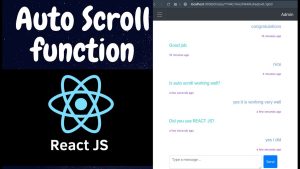Seamless Navigation – Harnessing React’s Power to Scroll Pages
Seamless navigation is a crucial aspect of modern web development and React, as a powerful JavaScript library, offers a wealth of tools and techniques to create smooth scrolling experiences that keep users engaged and satisfied. By harnessing React’s capabilities, web developers can take their page-scrolling functionality to the next level, offering a seamless and intuitive browsing experience. One of the primary advantages of using React for seamless navigation is its component-based architecture. React allows developers to break down complex user interfaces into reusable components. When it comes to scrolling pages, this means that specific elements, such as navigation bars or interactive sections, can be encapsulated within their own React components. This modularity not only promotes code reusability but also simplifies the management of scroll-related functionalities.

React’s Virtual DOM (Document Object Model) is another key feature that contributes to seamless navigation. The Virtual DOM efficiently updates and re-renders only the parts of the page that have changed, reducing the overall workload on the browser. This is particularly beneficial for scroll-heavy applications where real-time updates and animations are essential for maintaining a fluid user experience. With React, developers can create responsive, high-performance scroll interactions that feel natural and fluid. Incorporating React’s state management capabilities is pivotal in achieving seamless navigation. React’s state management system allows developers to control and synchronize the behavior of different components in response to user interactions. For scrolling pages, this means that developers can maintain a consistent scroll position across multiple sections or pages, ensuring a cohesive and intuitive browsing experience. Furthermore, React’s state management can be used to trigger animations, parallax effects or lazy loading of content, enhancing the overall user engagement.
React also seamlessly integrates with popular routing libraries, such as React Router, which facilitates the creation of single-page applications (SPAs) with smooth scrolling transitions between different routes. SPAs load content dynamically without full-page refreshes, chat scroll to bottom react creating a continuous and seamless browsing experience. React’s component-based structure complements SPAs by allowing developers to define individual route components that can be smoothly transitioned between as users scroll through the application. In conclusion, harnessing React’s power for seamless navigation is essential for creating modern web experiences that prioritize user engagement and satisfaction. By leveraging React’s component-based architecture, Virtual DOM, state management and routing capabilities, developers can craft scroll-intensive applications that feel responsive, performant and intuitive. Whether it is building a single-page application with smooth transitions or implementing complex scroll animations, React provides the tools necessary to elevate the user’s scrolling experience to a whole new level.
